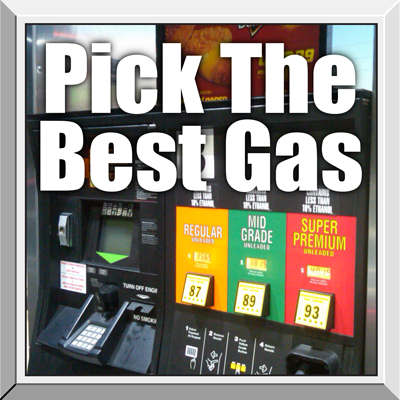Picking the right fuel matters!

 When a client with a gas-engine vehicle complains about performance problems like poor mileage, rough idle, tip-in hesitation, or hard-starts without a ‘check engine’ light, one of our first questions is about the fuel that client’s been using. When the answer is something like “whatever’s cheapest”, “whatever’s closest when I’m on empty” or “whatever; does it matter?” we know we need to help with some basic information about gasoline…
When a client with a gas-engine vehicle complains about performance problems like poor mileage, rough idle, tip-in hesitation, or hard-starts without a ‘check engine’ light, one of our first questions is about the fuel that client’s been using. When the answer is something like “whatever’s cheapest”, “whatever’s closest when I’m on empty” or “whatever; does it matter?” we know we need to help with some basic information about gasoline…
Editor’s note, 3/25
For years we have recommended our clients buy Top-Tier gas and suggested they avoid ARCO as the most common example of a unbranded gas station. We wrote the original article with that advice in mind, but client Anne S. pointed out that ARCO has recently begun including the additives that qualify it for Top Tier status. We still see performance problems that clear up with a change from ARCO gas so we still recommend avoiding it, but ARCO is now a Top Tier station. We’ve edited the article below to reflect this, we apologize for the error, and thanks to Anne for correcting us.
The short story:
Yes, fuel matters.
- Buy quality “Top Tier” fuel and you will get better mileage and save on repairs.
- “Top Tier” gas is available from branded stations like Chevron, Shell, Texaco, Exxon, or Mobil. A full list is available here.
- Don’t buy unbranded fuels from AM/PM, Space Age, Rocket, Safeway or any other unbranded or Ma-and-Pa outlets.
- Use fuel with the octane rating that your vehicle manufacture recommends.
The longer story:
What we know as “gasoline” is now a very complex cocktail that barely resembles fuels form years past. Things have changed since the day of the ‘Blender Pumps’ that allowed drivers to mix their own “regular” and “premium” to achieve the desired octane rating for their vehicles. Now drivers are less connected, and less concerned about the fuels going into their vehicles. For simplicity’s sake, we’ll only address issues regarding octane rating and fuel quality in this article.
Regular, Plus, or Premium?
Octane is a measure of a fuel’s ability to resist ‘knock’, otherwise known as “Ping” or “Pre-ignition”. The octane requirement of an engine varies with compression ratio, geometrical and mechanical considerations, and operating conditions. The higher the octane rating, the greater the fuel’s resistance to knocking or pinging during combustion. Octane ratings vary from Unleaded gas at 87 to Premium at 90 or higher.
The choice here depends on the engine you have. Newer vehicles control fuel mixture, camshaft and ignition timing, and just about every aspect of combustion short of the fuel itself. These vehicles can run on just about any gasoline sold, but that’s not the way to treat your vehicle if you expect a good return from it. Every vehicle has a manufacturer’s recommended octane rating and will perform best with fuels that meet those recommendations. Some modern high-compression engines need Premium gas for best operation, so follow the recommendation in your Owners Manual (or ask us!). If it recommends Premium, use it. When you run Regular octane rated fuel in a vehicle designed to run Premium you will experience degraded performance and decreased mileage. Cheap gas might seem like a savings but we think those savings are short term at best.
“Top Tier” Gasoline
“Top Tier” is a set of fuel standards agreed on by BMW, GM, Fiat/Chrysler, Honda, Toyota, VW, Mercedes, and Audi to increase engine cleanliness and performance. Top Tier fuels use a higher level of detergent additives compared to the minimum EPA standards, and they can’t contain metallic additives that can harm the emission system. Stations have to be certified as Top Tier Detergent Gasoline (TTDG) retailers so a station can’t just say they sell Top Tier gas. And, for stations that are certified, the Top Tier standards have to apply to all grades of gas they sell. As of 2016, there are 31 Top Tier distributors in the US; mostly the major brands like Chevron, Shell, Texaco, Exxon, or Mobil. A full list is available here.
It’s all about the additives
The main thing that sets Top Tier gas apart from everything else is its additives, and Techron is the first and probably still the best of these. Techron is a patented additive created by Chevron intended to keep impurities and residue from building up in your engine, particularly the delicate and easily-clogged fuel injectors. It really works and it’s worth having. Chevron introduced Techron into their gasoline starting in 1995, and it’s now available at Chevron, Texaco, and Caltex stations in all three grades of gas. It’s also available as a separate product for use with gasoline that doesn’t already have Techron added.
Stay away from low volume stations
We’re usually fans of small businesses, but when it comes to gas you should stay away from the out of the way “Mom-and-Pop shops”. There are very practical reasons. They probably sell un-branded fuel, and the volume of fuel sold could be much lower so it takes longer to go through a storage tank of gas. If so, beyond the poor quality of fuel it also may sit much longer, and be subject to separation, sedimentation, and water contamination. These are impurities you shouldn’t risk.
It just isn’t worth it
It may seem to make sense to save a nickel or even a dime per gallon at off-brand stations, or buy gas when and where it is convenient, but we don’t agree. Sure, you save at the pump now but you may pay it back with interest later. On top of protecting fuel injectors, sensors, catalytic converters and exhaust systems, it is really rewarding to have your vehicles performing at their best.
And one final tip…
Modern fuel pumps are electric and expensive! They live in the gas tank and are cooled by fuel. They work much harder and build more heat delivering those last couple of gallons from an almost-empty tank. Don’t drive with your tank continually between 1/4 tank and empty! Treat 1/4 tank as ‘empty’. Train yourself to start looking for gas at 1/4 tank instead of when the fuel warning light comes on. It costs just as much to keep the top half of the tank full as the bottom half, and your fuel pump will thank you!










